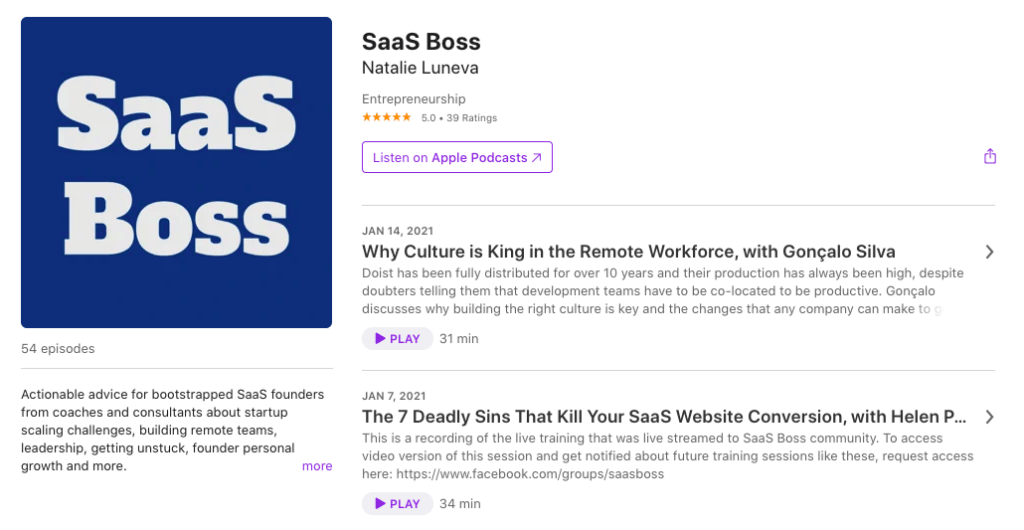Natalie Luneva is an extremely smart SaaS coach who assists SaaS companies with growth, clarity, and team performance. She helps SaaS companies optimize their website and product for conversion and growth.
Natalie also has an excellent podcast for SaaS founders and professionals called SaaS Boss, and a thriving group on Facebook under the same name SaaS Boss.

I set down with Natalie to discuss how SaaS founders should think about conversion optimization and what advice she has when it comes to marketing in the current environment.
Tell me about your business, what's your framework with SaaS companies?
Natalie went on to say that she does coaching and consulting for SaaS companies, primarily in 3 aspects:
- Marketing and growth
- Business clarity and business practices
- Improving team performance
This way Natalie says she helps SaaS companies identify high ROI opportunities.
Her 10 year experience in digital marketing helps her guide SaaS businesses in figuring out the right approach before diving into marketing.
Natalie says “as far as business clarity and business priorities, oftentimes founders think ‘I need help with SEO, or I need to launch PPC.’
But when you actually dive deeper, even in Google Analytics, you can tell that for example producing more content is not your problem, you're already getting enough traffic, you just need to learn how to convert it. So that's what I call identifying high ROI opportunities.”
What are the first steps when a company comes to you? What kind of questions do you ask and what do you tell them to prepare for you?
Natalie says that it starts with getting access to a few metrics and to Google Analytics. “In Google Analytics I see what's the trajectory. Are they increasing in traffic? Or decreasing? Compared monthly and year over year.”
“Then what’s their split by channel? For example Organic is maybe growing, but PPC is dropping. Then if they have goals set up properly I look at what's happening: is conversion of the website increasing? or decreasing?”
“If they don't have the goals set up then I do the next step which is getting data directly from their systems, not from Google Analytics.
Or I looks at software they use for revenue tracking like ProfitWell, where they tell me for example in the month of September of 2020, we've got 15 new trials, out of them we have 10 new customers. I basically try to looks at the whole funnel.”
“Then I create a spreadsheet with all of the metrics that I think are the most important. I compare that to where they were last year, two years ago, and I compare that to benchmarks.
For example, if I know that your website converts at 2%, from a visitor to a trial, that means that your conversion can be improved. So that's the number one thing that I would pay attention to, and not for example improving your SEO or pay per click or whatever a lot of founders think.”
Natalie says “founders tell themselves I need to increase the number of customers so I'm going to work on my SEO more. Well, that's often not how it works. Maybe you already have enough customers, but what's happening to your on-boarding? You might have activation bottlenecks, so you need to fix that first.
“Let's say you do have a 2% conversion rate from traffic to registrations or leads, you have some traffic if you already have 2% conversion rate on your website. Next, we check your onboarding: let's say 100 people requested the trial this month, how many of them actually ended up being a paying customer? Okay, 20%. That's not enough, we can improve that. Let me take a look at your onboarding sequence.”
“So it's an iterative process. I have specific steps that I follow, and also I look at the data as a whole, analyze it and ask additional questions.”
What additional metrics do you analyze when working with SaaS companies?
Natalie went on to say that part of her big spreadsheet is analyzing metrics like trial to paid conversion rate and churn. How many customers the company loses and also revenue in MRR month-over-month that they are losing to churn.
She analyzes the following as part of the onboarding process:
- What's happening?
- Why do customers leave?
- When do they leave?
- When did we stop communicating with them?
- Have we done our onboarding sequence and that's it?
- Or do we continue talking to them and sending out tutorials, news, messages or tips?
- Looking at everything that can be be improved.
Natalie says that comparing the growth of the conversion rate is very important, “it's not just, we have this number of new trials this month, it's how it compares to the number we had last month. And how it compares to the previous year."
"We then find for example that there is now a 6% growth rate month over month, while you had 2% consistently for the last eight months. So we can say that even 5% growth this month is a good growth, because you used to have 2%."
What are common mistakes SaaS companies make when it comes to conversions?
Natalie went on to say “The majority of the problems are related to the onboarding sequence. That's the number one thing that I look at when analyzing what can be improved.”
A few questions to ask will be" ‘does the onboarding process ask for a credit card when customers sign up for a trial?’ because if it does, then the conversion rate to paid should be higher with the credit card than without a credit card, because you filter out all those people on the prior step of signing up to trial when you ask for a credit card.
I then check 'how many steps the onboarding process has?' 'How often do the emails get sent out?' 'Are there any follow ups after the trial expires?'"
Oftentimes there's one or two emails, and the emails are ‘Hey, your trial has expired. Here's the link to go buy.'
But nothing about the benefit! People sign up to so many trials that they forget all the benefits that they are supposed to get from your tool, what kind of tool it is and what you are helping them with." You need to remind them about it and educate them."
“Oftentimes just finding those improvements in the onboarding sequence helps a lot. And making sure that customers who are in the trial get to their Aha! moment as soon as possible!
So do not send them six emails and then only the seventh email they are able to start using your tool or understand why it's useful, it’s way too late, people are not as patient these days."
"They want to benefit from using your tool on the first day and not wait until everything is set up. So it is important to make it as easy as possible. On the first day they should be able to start using your tool within a few minutes ideally."
"I look at the onboarding sequence to see how many follow ups there are and what kind of emails are sent. Can we improve how we communicate the benefits that the customer is going to lose from not upgrading from trial to paid?"
What’s a good practice in sending sequence emails in onboarding?
Natalie says there are two ways to do it:
One way is to send the same email to everyone, based on a time trigger: day one, two, three, five, seven post registration.
Another way is to send emails based on user actions. For example the user has done step two, but not step three, so the system should send an email talking about the benefit of step three. Instead of an email saying you are on the last day of your trial.
Natalie also mentioned that she tries to find a pattern of similarities between customers who don’t convert from free to paid. Similarities like maybe many of them are B2C, or many of them are in a certain industry. This way Natalie identifies the ideal customer profile to see if there are any opportunities to improve conversion rates by focusing on the best ICPs.
“When you know who is not your ideal customer and who is your ideal customer you can adjust your marketing to concentrate on reaching your ideal customers and drive better results.”
Once the conversion rate is fixed, do you then start planning the demand generation marketing activities?
Natalie says “Yes, that's where my 10 years of marketing background comes in handy.” Natalie mentioned that in particular she’s had good results with online summits, which provide better and higher quality leads than pay-per-click.
Natalie went on to say “hosting online summits is a great way to generate attendees who can be potential leads for the company, in addition to generating content, awareness, and also partner up with those people who are going to be speakers."
“You build those connections with speakers by allowing them to be a presenters at your event, and then later you can continue reaching out to them to explore collaborations, co-marketing and partnership opportunities.”
“I've done online summits recently for a few companies, and I have few more events lined up for this year. So I think this is a very interesting and exciting strategy for not just lead generation, content awareness and thought leadership, but also for partnerships.”
What goes into planning an online summit and how does it help SaaS companies optimize growth?
Natalie went on to say “you need to have at least two to three months of planning. For one event I had a month and a half of planning, which wasn't too bad. So I think you can do a month and a half.
But right now I try to stay within the two to three month period, just because you can plan all day long, but then there are other speakers that are involved, so you need to coordinate with a lot of people and make sure that their availability works, that they can prepare the sessions and the slides and everything that you need on time.”
When it comes to tools, Natalie says that HeySummit worked very well for her to manage a number of summits as far.
Natalie mentioned that running summits is so much easier right now because it’s online versus planning a summit in person “I don't think I would have been able to organize in person summits for so many companies and travel to all of those places. And for the speakers it would have taken that much more time and commitment to be able to participate. That's why doing online summits is so easy right now."
When it comes to promotion Natalie says that they also run Facebook ads to promote the event and increase signups, but it’s usually small budgets around $100-$200.
Natalie also said that when it comes to organic promotion they publish the event in multiple communities and share it with existing connections. As well as ask the speakers to promote the event which is a great way for the speakers to invite their audience.
Natalie is very bullish on doing online summits as a marketing strategy that can accelerate growth by creating market awareness and drive significant increase in leads for the SaaS company.
This concludes my conversation with Natalie, I learned a lot. The conversation also inspired me to want to learn even more and do online summits!
I subscribed to her excellent podcast that’s packed with a lot of amazing advice for SaaS companies. I highly recommend checking it out, it’s super informative.
To connect with Natalie you can visit her website natalieluneva.com, or find her on Twitter @Natalie_Luneva and the SaaS Boss Facebook group.

